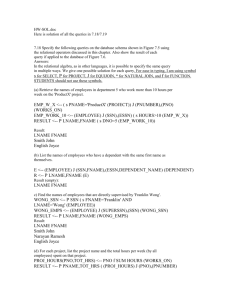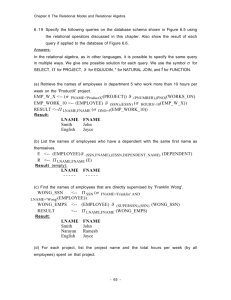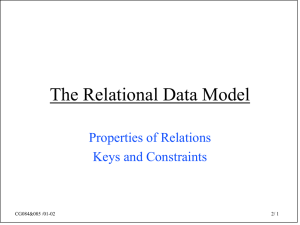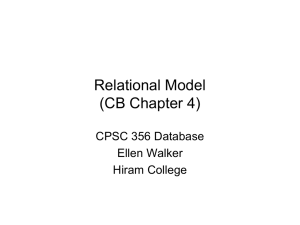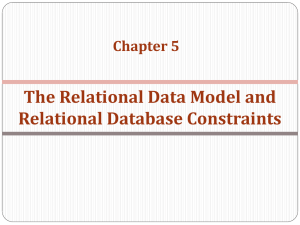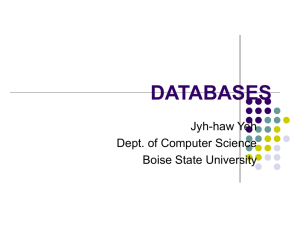Answer to Assignment 3
advertisement
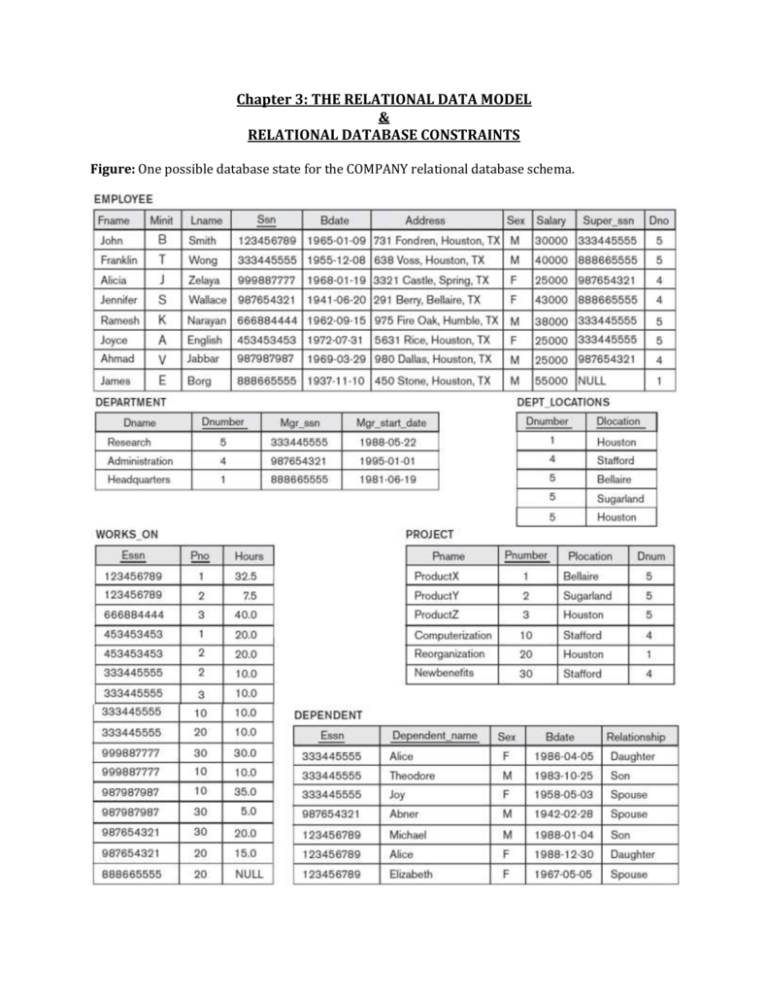
Chapter 3: THE RELATIONAL DATA MODEL & RELATIONAL DATABASE CONSTRAINTS Figure: One possible database state for the COMPANY relational database schema. 1. Suppose each of the following Update operations is applied directly to the database of above Figure, Discuss all integrity constraints violated by each operation, if any, and the different ways of enforcing these constraints: a. Insert <‘Robert’, ‘F’, ‘Scott’, ‘943775543’, ‘1972-06-21’, ‘2365 Newcastle Rd, Bellaire, TX’, M, 58000, ‘888665555’, 1> into EMPLOYEE. Violation No Entity integrity - Key constraint - Referential integrity - b. Insert <‘ProductA’, 4, ‘Bellaire’, 2> into PROJECT. Violation Yes Entity integrity - Key constraint - Referential integrity DNUM:2 -No tuple in the DEPARTMENT relation with DNUMBER=2 exists. Ways of enforcing: -Changing the DNUM to either 5, 4, 1 -Inserting a new tuple of DNUM=2 in the DEPARTMENT itself. c. Insert <‘Production’, 4, ‘943775543’, ‘2007-10-01’> into DEPARTMENT. Violation Yes Entity integrity - Key constraint DNUMBER=4 -It already exists in the DEPARTMENT tuple. Ways of enforcing: -Changing the value of DNUMBER which doesn’t exists and also not violate the key constraint. Referential integrity MGRSSN='943775543' - No tuple exists in the EMPLOYEE relation with SSN='943775543'. Ways of enforcing: -Changing the value of MGRSSN to an existing SSN value in EMPLOYEE. -Inserting a new EMPLOYEE tuple with SSN='943775543'. d. Insert <‘677678989’, NULL, ‘40.0’> into WORKS_ON. Violation Yes Entity integrity PNO=NULL -It cannot be NULL as it is the primary key in WORKS_ON Ways of enforcing: Key constraint - Referential integrity ESSN='677678989' -No tuple exists in the EMPLOYEE relation with SSN='677678989'. -Changing the value of PNO and also the value of PNUMBER should exist in the PROJECT relation. Ways of enforcing: -Changing the value of ESSN to an existing SSN value in EMPLOYEE. -Inserting a new EMPLOYEE tuple with SSN='677678989'. e. Insert <‘453453453’, ‘John’, ‘M’, ‘1990-12-12’, ‘spouse’> into DEPENDENT. Violation No Entity integrity - Key constraint - Referential integrity - f. Delete the WORKS_ON tuples with Essn = ‘333445555’. Violation No Entity integrity - Key constraint - Referential integrity - g. Delete the EMPLOYEE tuple with Ssn = ‘987654321’. Violation Yes Entity integrity - Key constraint - Referential integrity Ssn = ‘987654321’ -Many tuples exist in the WORKS_ON, DEPENDENT, DEPARTMENT, and EMPLOYEE relations that reference the tuple being deleted from EMPLOYEE. Ways of enforcing: -Deleting all tuples in the WORKS_ON, DEPENDENT, DEPARTMENT, and EMPLOYEE relations whose values for ESSN, ESSN, MGRSSN, and SUPERSSN. h. Delete the PROJECT tuple with Pname = ‘ProductX’. Violation Yes Entity integrity - Key constraint - Referential integrity Pname = ‘ProductX’ -Affects the other tuple which exists in the WORKS_ON relates that reference the tuple being deleted from PROJECT. Ways of enforcing: -Deleting the tuples in the WORKS_ON relation whose value for PNO=1 i. Modify the Mgr_ssn and Mgr_start_date of the DEPARTMENT tuple with Dnumber = 5 to ‘123456789’ and ‘2007-10-01’, respectively. Violation No Entity integrity - Key constraint - Referential integrity - j. Modify the Super_ssn attribute of the EMPLOYEE tuple with Ssn = ‘999887777’ to ‘943775543’. Violation Yes Entity integrity - Key constraint - Referential integrity SUPERSSN='943775543' -No tuple exists in the EMPLOYEE relation with SSN='943775543'. Ways of enforcing: -Inserting a new EMPLOYEE tuple with SSN='943775543'. k. Modify the Hours attribute of the WORKS_ON tuple with Essn = ‘999887777’ and Pno = 10 to ‘5.0’. Violation No Entity integrity - Key constraint - Referential integrity - 2. Consider the relation CLASS (Course#, Univ_Section#, Instructor_name, Semester, Building_code, Room#, Time_period, Weekdays, Credit_hours). This represents classes taught in a university, with unique Univ_section#s. Identify what you think should be various candidate keys, and write in your own words the conditions or assumptions under which each candidate key would be valid. Any relation schema may have more than one key. In this case, each of the keys is called a candidate key. It is common to designate one of the candidate keys as the primary key of the relation. This is the candidate key whose values are used to identify tuples in the relation. All possible candidate keys include the following: 1. (Univ_Section#) - If it is unique across all semesters. 2. (Semester, BuildingCode, Room#, TimePeriod, Weekdays) - If more than one course cannot be conducted in the same room during a particular semester. 3. (InstructorName, Semester) - If an instructor can only teach one course in each semester. 4. (Course#, Univ_Section#, Semester) - would be the candidate key, If (Univ_Section#) is not unique across all semesters.
